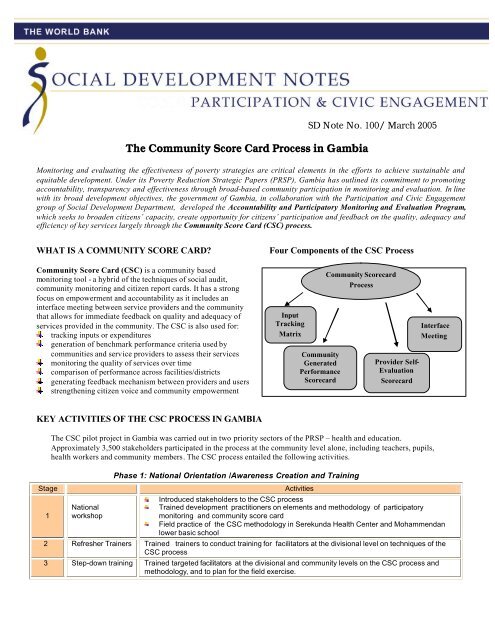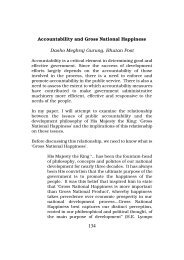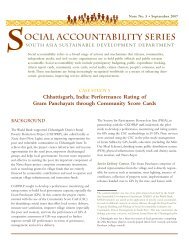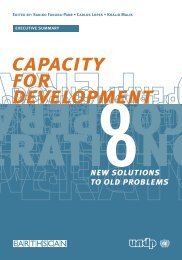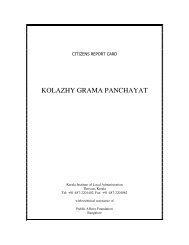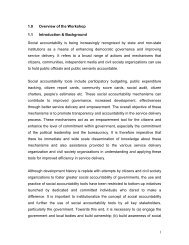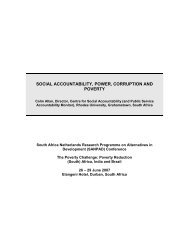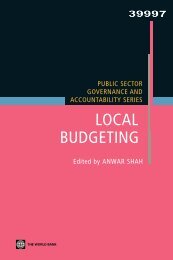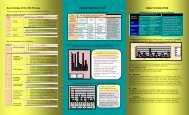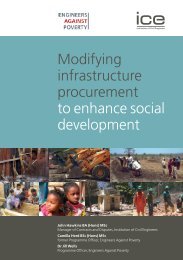The Community Score Card Process in Gambia
The Community Score Card Process in Gambia
The Community Score Card Process in Gambia
- No tags were found...
Create successful ePaper yourself
Turn your PDF publications into a flip-book with our unique Google optimized e-Paper software.
<strong>The</strong> <strong>Community</strong> <strong>Score</strong> <strong>Card</strong> <strong>Process</strong> <strong>in</strong> <strong>Gambia</strong>SD Note No. 100/ March 2005Monitor<strong>in</strong>g and evaluat<strong>in</strong>g the effectiveness of poverty strategies are critical elements <strong>in</strong> the efforts to achieve susta<strong>in</strong>able andequitable development. Under its Poverty Reduction Strategic Papers (PRSP), <strong>Gambia</strong> has outl<strong>in</strong>ed its commitment to promot<strong>in</strong>gaccountability, transparency and effectiveness through broad-based community participation <strong>in</strong> monitor<strong>in</strong>g and evaluation. In l<strong>in</strong>ewith its broad development objectives, the government of <strong>Gambia</strong>, <strong>in</strong> collaboration with the Participation and Civic Engagementgroup of Social Development Department, developed the Accountability and Participatory Monitor<strong>in</strong>g and Evaluation Program,which seeks to broaden citizens’ capacity, create opportunity for citizens’ participation and feedback on the quality, adequacy andefficiency of key services largely through the <strong>Community</strong> <strong>Score</strong> <strong>Card</strong> (CSC) process.WHAT IS A COMMUNITY SCORE CARD?<strong>Community</strong> <strong>Score</strong> <strong>Card</strong> (CSC) is a community basedmonitor<strong>in</strong>g tool - a hybrid of the techniques of social audit,community monitor<strong>in</strong>g and citizen report cards. It has a strongfocus on empowerment and accountability as it <strong>in</strong>cludes an<strong>in</strong>terface meet<strong>in</strong>g between service providers and the communitythat allows for immediate feedback on quality and adequacy ofservices provided <strong>in</strong> the community. <strong>The</strong> CSC is also used for:track<strong>in</strong>g <strong>in</strong>puts or expendituresgeneration of benchmark performance criteria used bycommunities and service providers to assess their servicesmonitor<strong>in</strong>g the quality of services over timecomparison of performance across facilities/districtsgenerat<strong>in</strong>g feedback mechanism between providers and usersstrengthen<strong>in</strong>g citizen voice and community empowermentFour Components of the CSC <strong>Process</strong>InputTrack<strong>in</strong>gMatrix<strong>Community</strong>GeneratedPerformance<strong>Score</strong>card<strong>Community</strong> <strong>Score</strong>card<strong>Process</strong>Provider Self-Evaluation<strong>Score</strong>cardInterfaceMeet<strong>in</strong>gKEY ACTIVITIES OF THE CSC PROCESS IN GAMBIAStage1<strong>The</strong> CSC pilot project <strong>in</strong> <strong>Gambia</strong> was carried out <strong>in</strong> two priority sectors of the PRSP – health and education.Approximately 3,500 stakeholders participated <strong>in</strong> the process at the community level alone, <strong>in</strong>clud<strong>in</strong>g teachers, pupils,health workers and community members. <strong>The</strong> CSC process entailed the follow<strong>in</strong>g activities.NationalworkshopPhase 1: National Orientation /Awareness Creation and Tra<strong>in</strong><strong>in</strong>gActivitiesIntroduced stakeholders to the CSC processTra<strong>in</strong>ed development practitioners on elements and methodology of participatorymonitor<strong>in</strong>g and community score cardField practice of the CSC methodology <strong>in</strong> Serekunda Health Center and Mohammendanlower basic school2 Refresher Tra<strong>in</strong>ers Tra<strong>in</strong>ed tra<strong>in</strong>ers to conduct tra<strong>in</strong><strong>in</strong>g for facilitators at the divisional level on techniques of theCSC process3 Step-down tra<strong>in</strong><strong>in</strong>g Tra<strong>in</strong>ed targeted facilitators at the divisional and community levels on the CSC process andmethodology, and to plan for the field exercise.
Phase 2: <strong>Community</strong> <strong>Score</strong> <strong>Card</strong> Pilot<strong>in</strong>gStage1 Selection offacilities234567<strong>Community</strong>Mobilization andSensitizationInput Track<strong>in</strong>g<strong>Community</strong>Performance<strong>Score</strong>cardService ProvidersSelf EvaluationInterface Meet<strong>in</strong>g(a conferencemeet<strong>in</strong>g of bothservice providersand users orbeneficiaries)Advocacy anddissem<strong>in</strong>ationActivities59 education and 15 health facilities were selected across the six ma<strong>in</strong> divisions <strong>in</strong> thecountry for the pilot program<strong>Community</strong> <strong>Score</strong> <strong>Card</strong> <strong>Process</strong>Facilitators organized the community and service providers through facility heads andcommunity or traditional leadersPrelim<strong>in</strong>ary session of both services providers and users or beneficiaries was held todiscuss the CSC objectives, methodology, significance and expectationsFacilitators determ<strong>in</strong>ed with service providers the government entitlements for eachfacilityBoth service providers and beneficiaries discussed facility entitlements, andcompleted <strong>in</strong>put track<strong>in</strong>g matrix –compar<strong>in</strong>g expected amenities with what wereactually providedBeneficiaries or the community developed facility performance assessment <strong>in</strong>dicators andused the group generated and standard <strong>in</strong>dicators to evaluate the adequacy of amenities<strong>in</strong> the health and education facilitiesBy way of performance assessment, service providers evaluated their own performanceus<strong>in</strong>g standard and group generated <strong>in</strong>dicatorsPerformance assessments and observations of each focus group were methodicallydiscussedProblems <strong>in</strong>hibit<strong>in</strong>g quality performance <strong>in</strong> the facilities were collated and harmonizedRecommendations and feedback to service providers were proposedAction plans were mutually developedProject completion report will be widely published and a National workshop on the CSCreport will beheld to elicit stakeholders feedback, and plans will be devised to<strong>in</strong>stitutionalize the CSC methodologyFINDINGS: EDUCATION FACILITYStandard and Group Generated IndicatorStandard IndicatorsGroup Generated IndicatorsPupils Staff ParentsAvailability of Teachers Food program Teachershous<strong>in</strong>gCleanEnvironmentAvailability of Furniture Transportation Discipl<strong>in</strong>e Discipl<strong>in</strong>eAvailability of Learn<strong>in</strong>gmaterialsTeach<strong>in</strong>gmaterialsLearn<strong>in</strong>gmaterialsLearn<strong>in</strong>gmaterialsAvailability of ToiletfacilitiesTeachersattendancePunctualityToiletfacilitiesPhysical<strong>in</strong>frastructureHealthServicesGoodadm<strong>in</strong>istrationObservationsPupils favored amenities that create aconducive atmosphere for physical andacademic development.Teachers believed <strong>in</strong> factors that enhancequality performance of teachers and pupils.Parents were much more concerned withthe safety and academic performance oftheir wards .Satisfaction with Primary Education Services <strong>in</strong> the Six Divisions – Central River, North Bank, Upper River, LowerRiver, Western and Kanif<strong>in</strong>g Metropolitan Council: Analysis of the Survey data <strong>in</strong>dicated that:Teachers received more than 70% approval rat<strong>in</strong>g <strong>in</strong> all regions except KMC (an urban area and more likely to attractmore pupils than available teachers).School facilities - furniture, core text books and toilets ranked below 40% <strong>in</strong> each region.Toilet facilities are either non- existent <strong>in</strong>adequate or appall<strong>in</strong>g <strong>in</strong> NB, URD, LRD and WD2
Recommendations for Improv<strong>in</strong>g Performance <strong>in</strong> Education FacilitiesParents and school adm<strong>in</strong>istration must lobby the m<strong>in</strong>istry of education to ensure timely and adequate supply ofthe needed materialsPool resources together and repair broken chairs, benches and tablesB<strong>in</strong>d torn textbooks with hardcoverCollaborate and provide new toilet fiacilties <strong>in</strong> the schools and <strong>in</strong>prove the quality of the exist<strong>in</strong>g onesCreate parent teacher associations (PTAs) <strong>in</strong> communties where they do not exist and support dormant PTAs tobecome effectiveEstablish and implement a reward program for teachers <strong>in</strong> order to attract and reta<strong>in</strong> qualifiied teachersEnsure that the CSC process is <strong>in</strong>stitutionalized, and implement the recommendations for improv<strong>in</strong>g educationfacilites at the grassroots level <strong>in</strong> an accelerated manner.FINDINGS: HEALTH FACILITYStandard and Group Generated IndicatorsGroup Generated IndicatorsStandard Indicators<strong>Community</strong>/StaffpatientsStaff Runn<strong>in</strong>g water Standard <strong>in</strong>frastructureAmbulance Electricity supply Electricity supplyDrugs Clean environment Clean environmentEssentialFurnitureStaff accommodationequipmentsObservationsBoth health workers and patients/communitiesfavored health performance <strong>in</strong>dicators that facilitatequality and effective service delivery. Beyondthese, however, service providers would wantconditions that enhance capacity and convenienceto deliver service to be <strong>in</strong>cluded <strong>in</strong> the performance<strong>in</strong>dicators.Satisfaction with Health Services <strong>in</strong> the Six Divisions – Central River, North Bank, Upper River, Lower River,Western and Kanif<strong>in</strong>g Metropolitan Council<strong>The</strong> overall level of satisfaction with the adequacy of health facilities was not vastly different compared with performanceassessment for education.<strong>The</strong> survey <strong>in</strong>dicated weak staff capacity with less than 30% satisfactory rat<strong>in</strong>g of adequacy of staff at healthfacilities across the regions.Availability of essential equipment received less than 15% satisfactory rat<strong>in</strong>g <strong>in</strong> all regions except KMC. It wasrecognized that lack of regular supply of electricity and water affects the provision of essential equipment. For<strong>in</strong>stance, about 40% of the health facilities <strong>in</strong>volved <strong>in</strong> the CSC process did not have regular supply of electricity,20% relied on solar panel for energy and 40% used generator-supplied energy. <strong>The</strong>se provisional sources ofenergy have <strong>in</strong>herent limited capacity and high ma<strong>in</strong>tenance cost.Although the overall rat<strong>in</strong>g for availability of drugs was fairly encourag<strong>in</strong>g (40% overall), the community felt thatdrugs were almost always <strong>in</strong> short supply except essential drugs like anti-malaria drugs which were availabledur<strong>in</strong>g malaria season.About 69% of the health services surveyed had at least one ambulance although about 30% of them were <strong>in</strong>deplorable condition. Availability of ambulance, therefore, received the highest rat<strong>in</strong>g <strong>in</strong> CRD, NBD, and LRDbut zero percent rat<strong>in</strong>g <strong>in</strong> KMC.Recommendations for Improv<strong>in</strong>g Performance <strong>in</strong> Health FacilitiesEstablish a health committee represent<strong>in</strong>g the community, and health staff should develop strategies and rules forenhanc<strong>in</strong>g efficient and effective health services delivery <strong>in</strong> the communityHealth Committee should ensure government meets entitlement packages <strong>in</strong>clud<strong>in</strong>g adequate supply of drugs,water, electricity, equipment, tra<strong>in</strong><strong>in</strong>g and supply of health workersHealth Committee should champion an agenda for promot<strong>in</strong>g cleanl<strong>in</strong>ess and clean habit <strong>in</strong> and around healthcentersEstablish a health supplemental fund<strong>in</strong>g program to ease reliance on government support (<strong>in</strong>adequate andunpredictable government flows have affected the quality of services provided <strong>in</strong> the hospital). In a fewcommunities, <strong>in</strong>dividuals took the <strong>in</strong>itiative and made voluntary contributions to help repair broken facilities <strong>in</strong>the cl<strong>in</strong>ic.3
Lessons Learned and Correspond<strong>in</strong>g Recommendations<strong>Community</strong> Empowerment: One of the importantlessons learned <strong>in</strong> the implementation of the CSCwas the role of the <strong>in</strong>terface meet<strong>in</strong>g betweenservice users and providers to empower thecommunity, through immediate feedback andmutually developed action plans.<strong>Community</strong> Participation: <strong>The</strong> CSC <strong>Process</strong>enabled maximum participation of a wide range ofstakeholders from various towns and villages.More than 55 development practitioners took part<strong>in</strong> the national refresher tra<strong>in</strong><strong>in</strong>g and about 3,500participants were <strong>in</strong>volved <strong>in</strong> the CSC process atthe community level.Self-help spirit: <strong>The</strong> CSC process revived theself-help spirit among communities expressedlargely through <strong>in</strong>dividual voluntary f<strong>in</strong>ancialcontributions, and the emphasis on communityroles <strong>in</strong> address<strong>in</strong>g majority of the problemsconfront<strong>in</strong>g facilities <strong>in</strong> the community.Awareness Creation: <strong>Community</strong> members wereenlightened about expected quantity and quality ofselected services <strong>in</strong> the their communities<strong>The</strong> Scope of the CSC <strong>Process</strong>: <strong>The</strong> CSC projectwas ambitious <strong>in</strong> terms of coverage. Though a pilotprogram, it expanded across the entire country<strong>in</strong>volv<strong>in</strong>g 59 education facilities and 15 healthservices.<strong>The</strong> CSC Focus: Performance <strong>in</strong>dicators werefocused more on measur<strong>in</strong>g quantity and less onquality and output of the facilitiesData Management and Analysis: Datamanagement and analysis posed a challenge forthe CSC result<strong>in</strong>g <strong>in</strong> some delays <strong>in</strong> produc<strong>in</strong>gsurvey results.This notwithstand<strong>in</strong>g, an evaluation of participantsperceptions on the entire CSC process, us<strong>in</strong>g post programevaluation questionnaire would have provided a fairlyelaborate <strong>in</strong>formation on the general acceptability of themethodology.An extensive community focused program of this k<strong>in</strong>drequires adequate time for consultation and sensitization.Participants <strong>in</strong>dicated that an extended time for sensitizationwould have been appropriate.Importance of <strong>in</strong>formation shar<strong>in</strong>g, dissem<strong>in</strong>ation of projectoutcomes, advocacy efforts and plann<strong>in</strong>g for how to<strong>in</strong>stitutionalize CSC and social accountability processes atcommunity level would further resonate with communitydriven <strong>in</strong>itiatives <strong>in</strong> address<strong>in</strong>g development problems.Institutionalization of the CSC process would be critical <strong>in</strong>open<strong>in</strong>g opportunities for community members to expressgrievances about the quality of services providedThough nation wide coverage was laudable, the program’sscope ought to be considered <strong>in</strong> the context of availableresources and capacity. For example, the scale of theexercise presented challenges which could be revisited,<strong>in</strong>clud<strong>in</strong>g balanc<strong>in</strong>g a focus on the use of the CSC as a datamanagement tool versus an empowerment process.Measur<strong>in</strong>g adequacy of services is important, but a CSCprocess that is designed to measure both quality andadequacy of services would fairly reflect communitypreferences <strong>in</strong> identify<strong>in</strong>g performance targets.Mak<strong>in</strong>g adequate provision for capacity and resource needsfor data management and analysis would greatly enhancethe CSC process. Quality tra<strong>in</strong><strong>in</strong>g at the beg<strong>in</strong>n<strong>in</strong>g ofexercise and close supervision throughout the CSC exerciseought to be considered.General Observations on the <strong>Community</strong> <strong>Score</strong> <strong>Card</strong> <strong>Process</strong> <strong>in</strong> <strong>Gambia</strong><strong>The</strong>re was strong support for the CSC methodology and recommendation for the tool to be nurtured for foster<strong>in</strong>gcommunity empowerment and participation at the local level.<strong>The</strong> CSC process succeeded <strong>in</strong> extract<strong>in</strong>g community grievances about the quality and adequacy of health andeducation services at the community level.<strong>The</strong> process created a great deal of awareness on the relevance of CRC and empowered the community toappreciate its value.<strong>The</strong> pilot project revealed that both service providers and the community were adequately <strong>in</strong>formed about thenature and scope of their education and health needs. ••This note was prepared by Gabriel Dedu and Gibwa Kajubi of the Participation and Civic Engagement Group of the Social Development Department.For more <strong>in</strong>formation on Social Accountability and Participatory Monitor<strong>in</strong>g and Evaluation, visit http://www.worldbank.org/participation.Additional copies can also be requested via e-mail: socialdev@worldbank.org4


